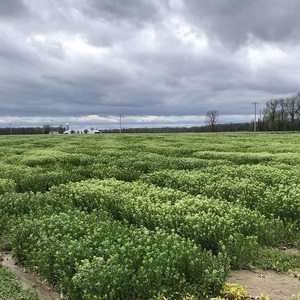CoverCress gets $5M in new financing for low CI crop development

Photo: CoverCress Inc.
April 13, 2020
BY CoverCress Inc.
CoverCress Inc. (formerly Arvegenix Inc.) has closed a $5 million follow-on equity investment round to continue its development of a new winter oilseed crop named CoverCress. This crop enables farmers in the southern half of the Midwest to grow three crops each two years, getting more from their existing farmland and equipment. CoverCress is planted at corn harvest in fall and is harvested immediately prior to soybean planting in May. In addition to new revenue from the oilseed crop, it also builds soil health, and holds soil and nutrients in place over winter as a cover crop. Its grain contains oil and protein similar to that of canola, with a very unique feature: a very low carbon intensity.
“We have had significant interest from companies investigating our potential to produce and scale this low carbon intensive oil for bio and renewable diesel markets, as well as companies seeking more nongenetically modified protein meal sources,” said Jerry Steiner, CEO of CoverCress.
The company was founded in 2013 and based its work on developing CoverCress from the native plant pennycress through plant breeding and the new genome-editing tools. It has built its team to more than 20 members plus a broad partnership with Illinois State University, the University of Minnesota and Western Illinois University, including participation in a large USDA grant program called iprefer. “The broad partnership base is designed to enable this opportunity, originally from work at the USDA in Peoria, Illinois, and advanced by these universities to become a commercial opportunity for farmers across the Midwest,” Steiner said. “It’s something that no single partner could do alone.”
Advertisement
Advertisement
This new funding supports CoverCress’ planned commercialization in fall 2021, with the goal of ultimately growing to millions of acres across the southern Midwest.
The investment round was led by Fulcrum Global Capital and Hermann Companies. Other investors include Prelude Ventures, Leaps by Bayer, St. Louis Arch Angels and Prolog Ventures, as well as continued investment from some founders and employees.
Advertisement
Advertisement
CoverCress also announced the expansion of its leadership team with Mike DeCamp joining as chief operating officer. DeCamp will initially focus on building the value chain to support the company’s 2021 commercial launch. He has more than 30 years of diversified experience in agribusiness, corporate finance, law, corporate strategy and M&A. He most recently spent eight years with Teays River Investments, an ag-focused investment firm. Prior to that, DeCamp spent more than a decade with Monsanto in various legal, corporate strategy and operational roles, including the development of an entrepreneurial business model that directly served farmers through regional corn and soybean seed companies.
“We have been very fortunate to have a committed group of investors,” Steiner said. “Our core group of investors has reinvested each opportunity since 2015. This stability has led to great progress in the challenge of developing a new crop and value chain. We are pleased that as we have advanced our crop development, farmers have shown great interest in learning how to integrate this new cash crop into their operations. They like this new cover crop opportunity that also generates income for them.”
John Peryam, partner at Fulcrum Global Capital, said, “This is a critical time for innovation that helps agriculture be a bigger part of the solution to the changing climate. CoverCress does this by making a low carbon intensity feedstock and a new source of carbon sequestration for Midwest farmers, without replacing the exiting corn and soybean opportunity.”
Rick Holton of Hermann Companies added, “Being part of the 39N Ag innovation ecosystem in St Louis has really helped CoverCress accelerate the delivery of this new technology for Midwestern farmers.”
Related Stories
CountryMark on July 22 celebrated the completion of more than $100 million in upgrades at its refinery in Indiana, including those related to soybean oil storage. The facility produces renewable diesel via coprocessing technology.
ATOBA Energy and Air Moana are partnering to implement scalable solutions for the supply of SAF. The collaboration aims to ensure long-term SAF availability while supporting local initiatives to develop sustainable fuel production in Tahiti.
Neste Corp. on July 24 released second quarter results, reporting record quarterly renewable product sales volumes despite weaker margins. SAF sales were up nearly 80% when compared to the first quarter of 2025.
Valero Energy Corp. on July 24 released second quarter results, reporting a profitable three-month period for its ethanol segment. The renewable diesel segment posted a loss, but the company’s new sustainable aviation fuel (SAF) unit operated well.
The IRS on July 21 published a notice announcing the 2025 calendar-year inflation adjustment factor for the Section 45Z clen fuel production credit. The resulting adjustment boosts maximum the value of the credit by approximately 6%.
Upcoming Events










